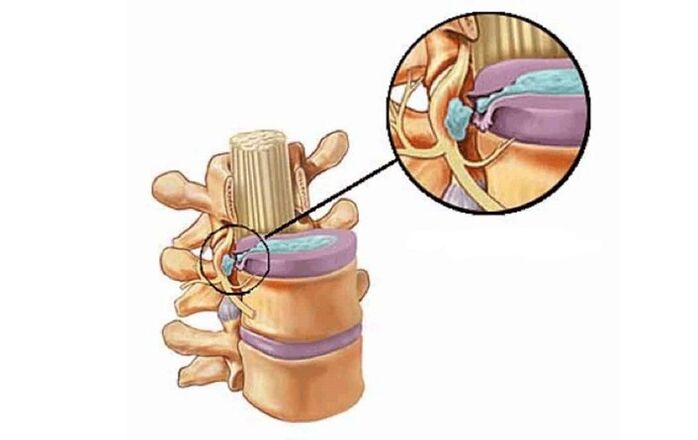Osteochondrosis rarely develops in the thoracic spine - the intervertebral discs in it are smaller and thinner than in the cervical or lumbar spine. The chest area is less mobile, the main burden falls on the ribs and the sternum.
In contrast to cervical and lumbar osteochondrosis, chest symptoms differ only in the location of the pain. The nature of the pain and its duration are similar. If there is a prolapse in the chest area, the spinal cord is not affected. Read about it and more.
Stages of pathology
Over time, osteochondrosis usually progresses. Depending on the severity of the manifestation, the pathology is divided into 4 stages.
Preclinical
There is minimal disruption in the spine. There may be a mild pain syndrome, the back muscles tense. It is possible to develop thoracic algae - chest pain - but this is a rare occurrence.
Discogenic sciatica
The structure of the intervertebral discs changes. Moderate pain may occur in the affected part of the spine. The patient is productive. But his muscle endurance indicators are declining.
Vascular radicular
At this stage the annulus fibrosus is completely destroyed. A herniated disc forms, the deformation process of the fiber ring continues, which leads to its breakage. Then the nucleus pulposus falls into the space under the ligaments. A herniated disc develops. The process affects the tissue on the intervertebral disc, the work of blood vessels, muscles, nerves and ligaments is disrupted. The disease becomes chronic.
Change in the shape of the bone structure
The eddy becomes coarser, its surface becomes ribbed, uneven. Muscles begin to contract spontaneously, resulting in limited mobility of the entire spine or a specific vertebra. The nerves that extend from the spinal cord become pinched. This leads to a deterioration in the impulses sent by the brain to the tissues and organs of the body.
The mobility of the entire spine is retained, but individual vertebrae become fragile and can easily collapse. If left untreated, the disease will move to the fourth stage.
Regeneration of intervertebral disc tissue and replacement of scar tissue
The damaged disc cannot perform its functions well, which leads to the convergence of the bodies of adjacent vertebrae. This leads to abnormalities in the intervertebral joints known as spondyloarthrosis. In this case, the vertebrae may twist or shift in relation to the neighboring vertebrae.
The body switches on its own compensation mechanisms. In order to relieve the damaged intervertebral disc, the vertebra flattens and grows in width. This increases its area. And the collapsed tissue of the annulus fibrosus can be replaced with bone.
Sometimes this will relieve the pain, but as the vertebrae grow, they make the spinal holes even tighter - the nerve gets pinched.
Symptoms of the disease
Often times, symptoms of breast osteochondrosis are caused by the following factors:
- the age of the patient;
- Spinal inclination;
- Stage of development of the disease;
- the patient's condition is remission or exacerbation of the disease.
Symptoms also include:
- Radiculopathy - painful damage to the nerve endings of the spinal cord;
- abdominal syndrome;
- Heart syndrome, changes in the heart muscle - it is characterized by severe pain and does not respond to nitroglycerin;
- Lung syndrome: congestion, hypoxia occurs in the lungs;
- paresthesia - a feeling of "goose bumps" on the body;
- pain in the area of the compressed nerve;
- decreased sensitivity to temperature changes and touch;
- Violations of the motor function of the spine.
The patient's body temperature does not rise. This will serve as a sign that will help you distinguish the pathology.
The degree of the disease
lumbago
It is a sharp pain that penetrates the body. It manifests itself when lifting heavy objects and other physical activity - the pain is similar to an electric shock.
Morphologically, excessive stress leads to an unexpected rupture of the intervertebral disc capsule. This traumatic injury leads to irritation of the nerves - pain occurs.
The muscles are tense and this is well expressed. The lordosis of the lumbar spine is smoothed. This redistributes the load and compresses the intervertebral disc even more, which leads to edema, which increases the pain.
If the pathology is concentrated in the neck area, then cervicalgia occurs - it is manifested by pain when turning the head and palpation of the muscles of the neck. Often with an exacerbation, cervicocranialgia is observed, which is manifested in the fact that a person has a severe headache in the back of the head. You may experience tinnitus, dizziness, a sensation of fly in the eyes and toothache.
dizziness
They occur as a result of narrowing of the cavity of the spinal canal. The intervertebral disc protrudes and compresses the vessels. The brain is unable to get the amount of blood it needs. You can have a severe headache, numb hands, and sore shoulders.
Difficulty breathing which prevents enough oxygen from reaching the brain. This leads to sharp pain in the heart area.
Intervertebral hernia
At this stage of development, the picture looks quite serious - the spinal canal and intervertebral cavities are severely narrowed. This can cause a hernia to form - a dangerous defect. Often it is necessary to resort to surgical intervention at this stage of the disease.
Treatment for third degree osteochondrosis depends on root compression. It is possible to use the same techniques as in the second degree. However, if the pain persists within 15 days and there are symptoms of an incident (vertebral prolapse), surgery is required.

Growths on the vertebrae
As a rule, at this stage of the disease, the manifestations of the hernia disappear, the symptoms of the disease are less pronounced, but it is noticeable that the spine is unstable, the vertebrae can slip or twist against each other.
At this point, the growth of the vertebral bodies may begin - this is called osteophytes. The growths lead to a compression of the spinal nerves, there is an overlap of the spinal canal, the so-called secondary spinal canal stenosis. This allows compression of the spinal cord, which leads to ischemia.
This degree of the disease also includes the consequences of previous surgeries to remove the inguinal hernia. They can express themselves as disturbed innervation, paresis, inflammation.
Dorsago and dorsalgia
Symptoms of thoracic osteochondrosis are directly related to the area of the spinal lesion. The most common vertebral syndromes are dorsago and dorsalgia.
Dorsago manifests itself as a sudden severe pain that occurs in the chest area. This often happens when a person is in a sitting position for an extended period of time without changing their posture. Pain can occur when a person's position is physiologically uncomfortable. In addition, it is possible to carry out monotonous work over a long period of time.
Dorsago is also called "chest lumbago". The muscles of the back and chest become so cramped that breathing becomes difficult.
Sometimes the pain goes along the ribs to the sternum, radiates to the area of the shoulder blade. Sometimes the patient may feel like it is a myocardial infarction. However, when performing an electrocardiogram, no deviations from the norms are found. If you take nitroglycerin or any other heart medicine, there will be no result.

Avoid staying in one position for long periods of time. Sedentary work is a leading cause of osteochondrosis.
Dorsalgia is mild pain that occurs over a long period of time, sometimes up to these weeks. The inflamed part of the spine causes "dull" pain. This is uncomfortable, so the person usually comes to the doctor.
Dorsalgia can be expressed in that:
- Pain worsens when the person breathes deeply or coughs;
- Muscles are overloaded;
- motor activity in the neck or lumbar area decreases;
- there are muscle spasms;
- the pain is worse at night and when the person is physically active.
Dorsalgia is superior and inferior. With the first, the main painful manifestations are concentrated in the upper chest, in the neck. In the second case, it hurts mainly in the sacrum and lower back.
The symptoms of dorsalgia are very similar to the first manifestations of pneumonia. This is important in order to diagnose the disease in a timely manner. If the diagnosis is wrong and treatment is prescribed, the patient's condition will only worsen.
When a woman breastfeeds her baby, such manifestations of osteochondrosis can occur. In this situation, it is necessary to treat the disease only by contacting a doctor, taking into account all the nuances.
It is important to weigh all the risks of taking certain medications so as not to harm the baby's health and your own.
Atypical symptoms
In some cases, the symptoms of thoracic osteochondrosis are completely atypical. A person may not even be aware of the disease, as the symptoms are often similar to those of other pathologies. They should be looked at in more detail and the situation analyzed as a whole:
- the appearance of pain mimicking the heart, developing with angina and myocardial infarction, is possible; Coronary dilatation drugs like nitroglycerin have no effect; and the EKG shows no abnormalities;
- pain may appear, similar to those that appear in women with the development of diseases of the mammary glands; this pain can last a long time; the examination does not reveal any problems in the mammary glands;
- the pelvic region and abdomen can be painful, with symptoms similar to gastritis and colitis; Pain under the right rib can be observed, similar to those that characterize hepatitis or cholecystitis; digestion is usually disturbed - this is also a characteristic symptom of osteochondrosis, which occurs due to disorders of the innervation of internal organs; it is necessary to find out what caused the disruption of the digestive process of food, is this really the cause of osteochondrosis in the chest;
- the process of urination and sexual function may be disturbed, as the innervation in the genitourinary system is distorted;
- as thoracic osteochondrosis worsens, there may be long-term, weeks-long sternum pain very similar to that seen in diseases of the mammary gland; A visit to the mammologist will allow you to identify the cause of the pain.
These symptoms are associated with manifestations of back pain, as well as intercostal neuralgia. The appearance of atypical symptoms is usually observed in the evening. There is usually no white man in the morning. Pain increases as the day progresses, when the conditions are created for it, and provokes pain.
























